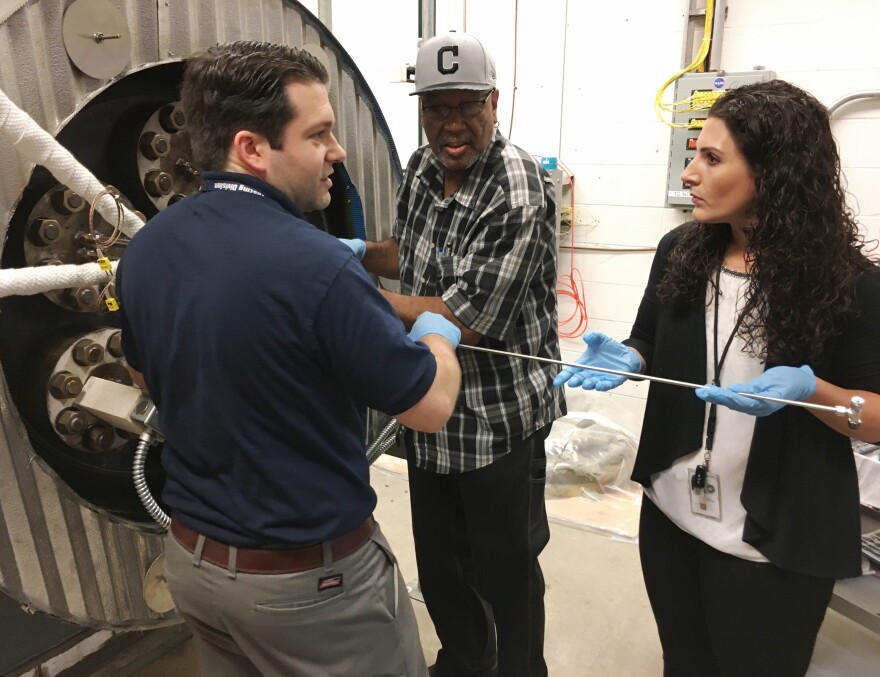It’s the namesake of the mythical goddess and synonymous with feminine beauty, but the reality of the planet Venus is anything but gentle.
Conditions on the surface are so harsh that all of our efforts to study it over the decades have provided only scant details.
But researchers in Cleveland are trying to change that.
In this week’s Exploradio, WKSU’s Jeff St.Clair looks at efforts to bring a little bit of Venus to planet Earth.
We’re at NASA Glenn research center in Cleveland and it’s the moment of truth.
Engineers are unscrewing bolts securing the mouth of a massive metal cylinder called the Glenn Extreme Environments Rig or GEER.

Leah Nakley is head of the project. She's understandably excited after a record 80 days since the chamber was sealed and programmed to replicate our neighboring planet.
“Basically we fill it with the atmosphere, heat it up and pressurize it so then you have the exact conditions that are on the surface of Venus inside that tank,” says Nakley.
It's the largest and most accurate simulator of conditions on other planets.
With the bolts finally off, a metal tray holding marble-sized samples of rocks and minerals is gently drawn out and set on a cart.
The samples belong to Case Western Reserve University planetary sciences grad student Brandon Radoman-Shaw who points to one of the Venus tested rocks - "You can see this really white mineral, right on the end - that was blue…”
Eighty days on Venus has radically altered the chemical make-up of the material.

Radoman-Shaw is testing the survival rate of various rocks on the surface of Venus, where pressures and temperatures are so high that instead of a gas, the mostly carbon dioxide atmosphere is a viscous mixture called a supercritical fluid.
“And a supercritical fluid is really dense, and we know that it’s able to strip certain compounds out of materials – that’s what they use to decaffeinate coffee, so we already know that it’s pretty strong and it can react very forcefully with certain minerals.”
With surface temperatures that would melt lead, pressures 100 times that on Earth, and clouds of flesh-melting acids, Case Western planetary scientist Ralph Harvey puts it another way...
“Venus is a hell hole,” he says.
Venus - a tough place to work
A Soviet program in the 1970’s provided the first clues of conditions on Venus.
Initial probes failed within minutes of landing on the surface, says Harvey.
Finally, through a process of trial and error, he says, "the last couple of them lasted a few hours and we got some interesting data," but he adds, "a tough place to work.”
Now NASA Glenn engineers are using the GEER chamber to test a new generation of electronics that can better survive the rigors of Venus.

NASA’s Phil Neudeck is part of a team that developed a super durable computer chip that lasted 21 days in the Venus simulator.
“This test was a major leap forward," says Neudeck, "This was the first test to show multi-week operation of any electronics in a Venus environment.”
Neudeck says the breakthrough opens the door for longer term explorations of our hostile neighbor.
“Until this test," he says, "the electronics were considered the limiting factor of a Venus mission.”
He says the work at Glenn is a game-changer.
“Nobody believed that we could do this, until we showed that we could do it.”

NASA Glenn physicist Geoffrey Landis has long envisioned exploring our sister planet.
“Venus is in many ways Earth’s evil twin,” he says.
Similar in size to Earth, he says our planetary histories started out alike, but went in wildly different directions.
“Venus was subject to the runaway greenhouse effect, where the temperatures kept rising and that eventually led to the oceans of early Venus boiling away and putting all of the water into the atmosphere where it was lost.”
The mysteries of Venus
Landis is also an award-winning science fiction author.
He says that while the surface of Venus is uninhabitable, the upper atmosphere is much cooler and calmer.
In fact, around 30 miles up, ships filled with air would float amid the clouds.
"Nobody believed that we could do this, until we showed that we could do it." - Phil Neudeck, NASA Glenn
In one story Landis pictured Venusian colonies - “Entire cities that were floating above the surface in that sort of Earth temperature and Earth pressure region.”
But he says there is one drawback, “and that’s that those pretty white clouds are actually concentrated sulfuric acid.”
You may ask, why would anyone want to go there?
Landis says apart from the thrill of interplanetary adventure, studying Venus allows us to better predict our own climatic future.
“We learn about our own planet best," he says, "by comparing it to other planets.”
He says we may even find microbial life forms in that Earth-like zone.
Many tempting mysteries await us on Venus and scientists at NASA Glenn are making significant strides toward solving them.









